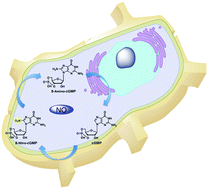Nitric oxide promotes recycling of 8-nitro-cGMP, a cytoprotective mediator, into intact cGMP in cells†
Abstract
8-Nitro-cGMP is an endogenous

* Corresponding authors
a
Graduate School of Life Sciences, Tohoku University, 2-1-1 Katahira, Aoba-ku, Sendai 980-8577, Japan
E-mail:
arimoto@biochem.tohoku.ac.jp
Fax: +81 22 217 6204
Tel: +81 22 217 6201
b Department of Microbiology, Graduate School of Medical Sciences, Kumamoto University, 1-1-1 Honjyo, Kumamoto 860-8556, Japan
8-Nitro-cGMP is an endogenous

 Please wait while we load your content...
Something went wrong. Try again?
Please wait while we load your content...
Something went wrong. Try again?
Y. Saito, T. Sawa, J. Yoshitake, C. Ito, S. Fujii, T. Akaike and H. Arimoto, Mol. BioSyst., 2012, 8, 2909 DOI: 10.1039/C2MB25189B
To request permission to reproduce material from this article, please go to the Copyright Clearance Center request page.
If you are an author contributing to an RSC publication, you do not need to request permission provided correct acknowledgement is given.
If you are the author of this article, you do not need to request permission to reproduce figures and diagrams provided correct acknowledgement is given. If you want to reproduce the whole article in a third-party publication (excluding your thesis/dissertation for which permission is not required) please go to the Copyright Clearance Center request page.
Read more about how to correctly acknowledge RSC content.
 Fetching data from CrossRef.
Fetching data from CrossRef.
This may take some time to load.
Loading related content
